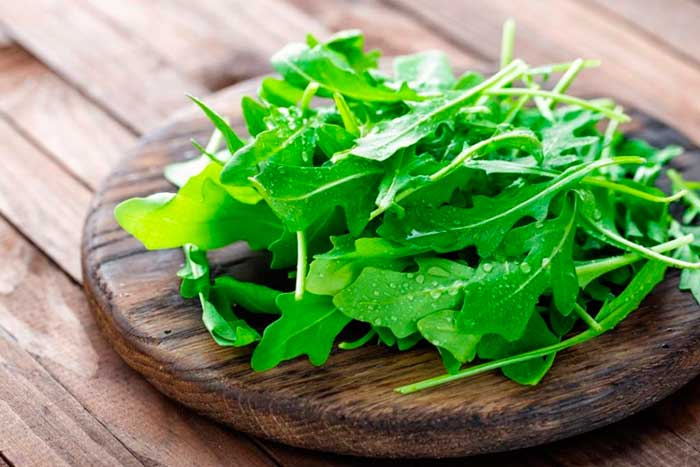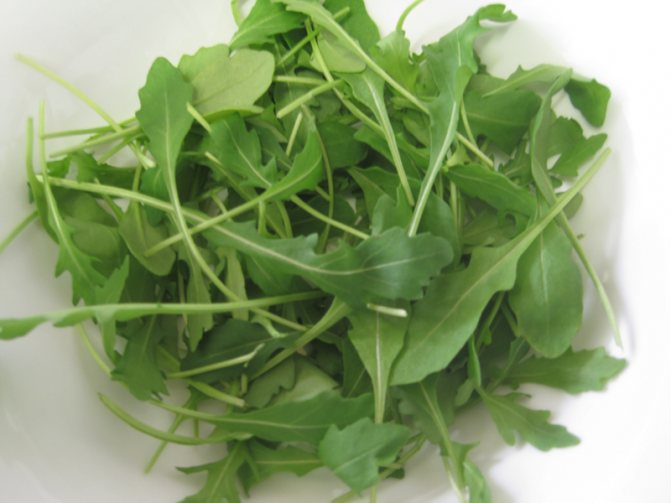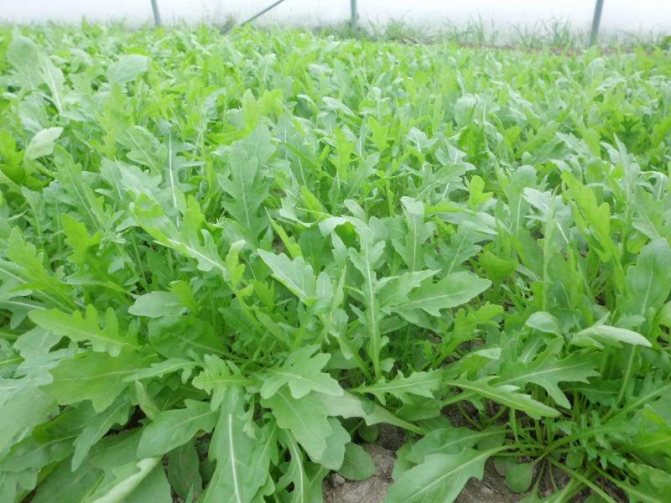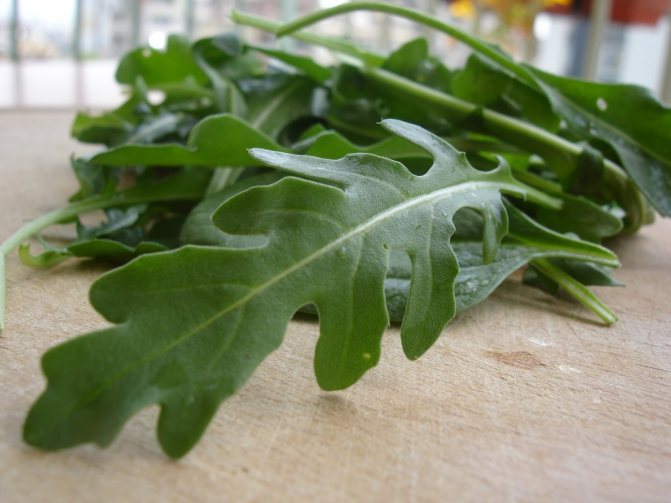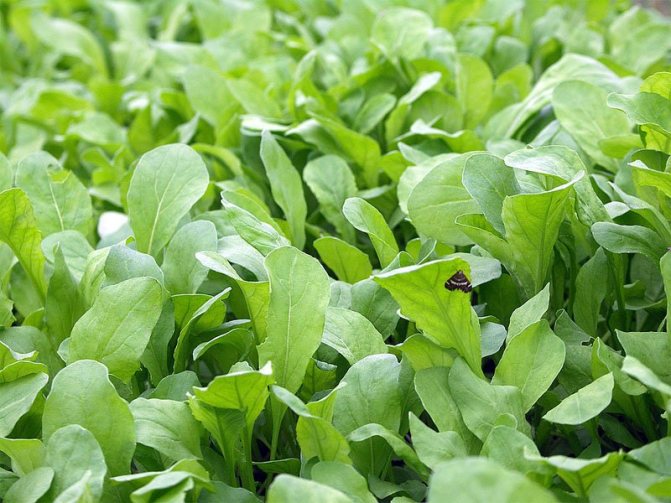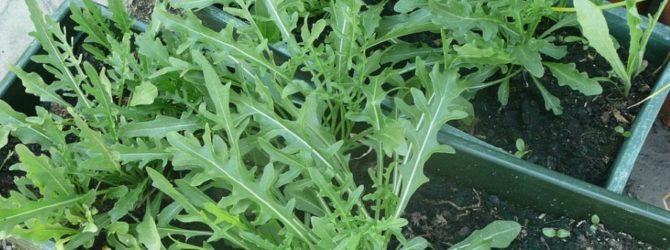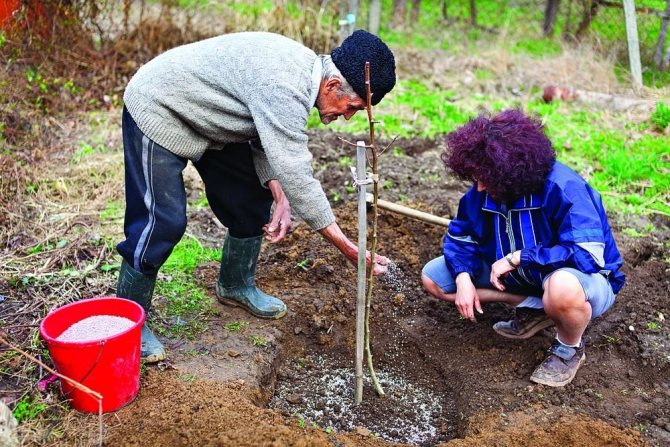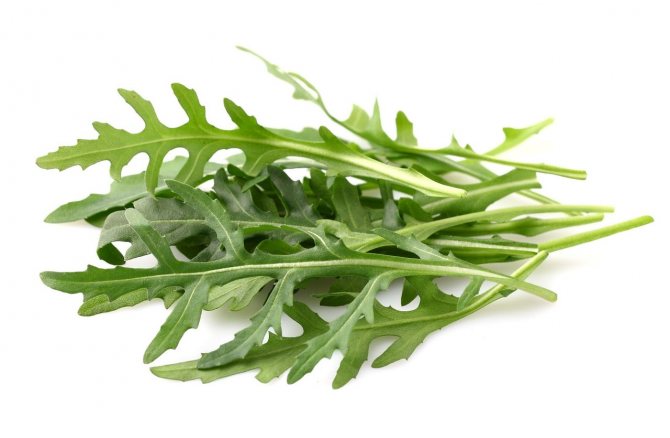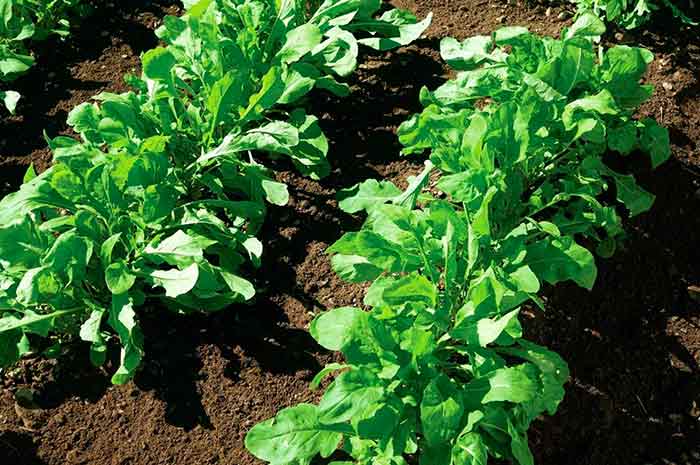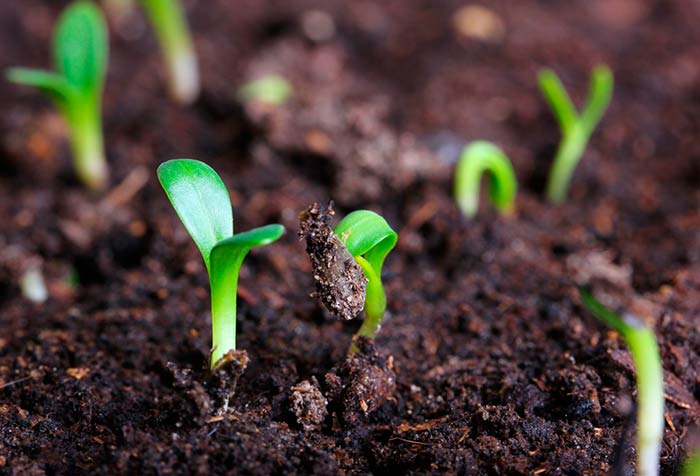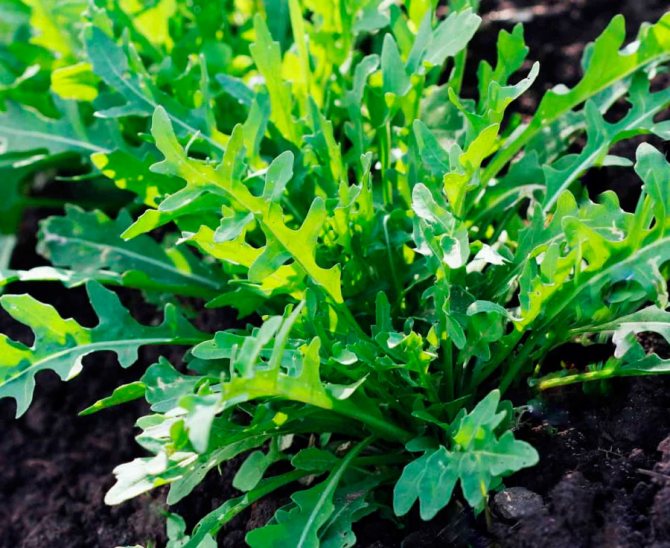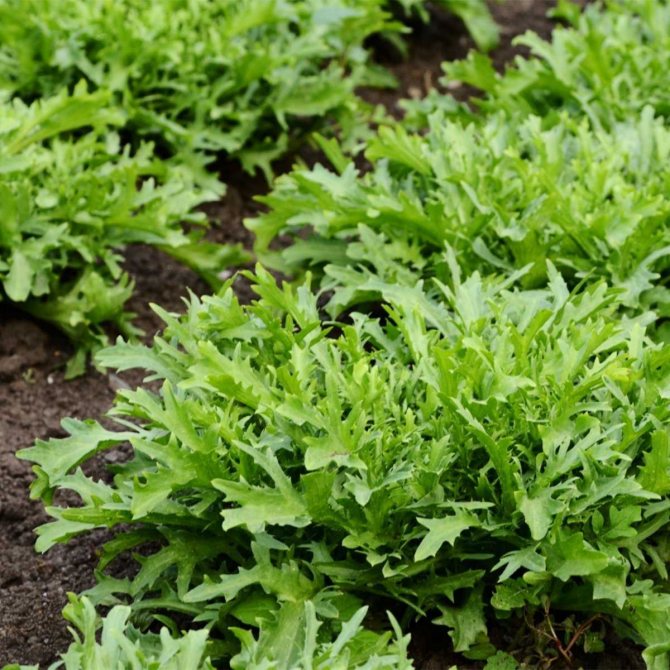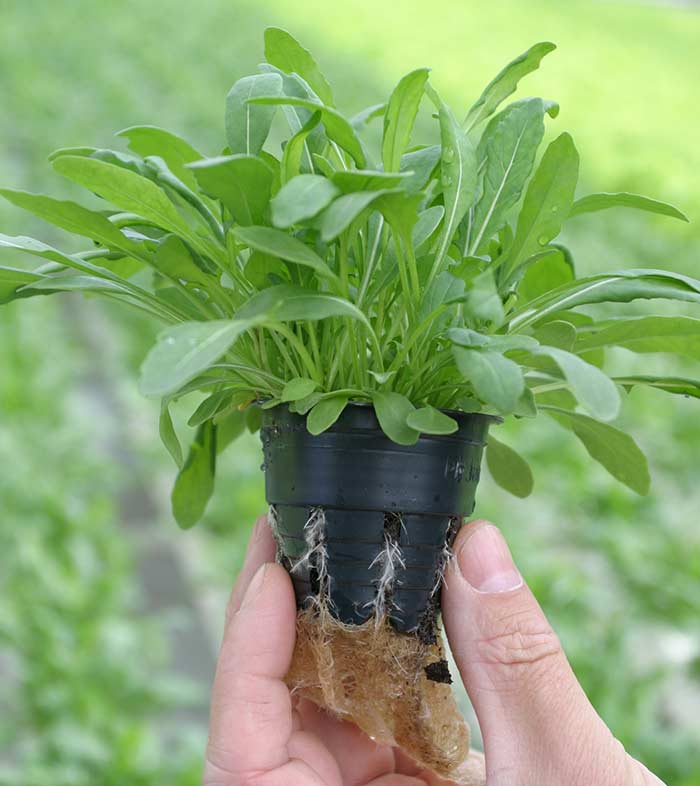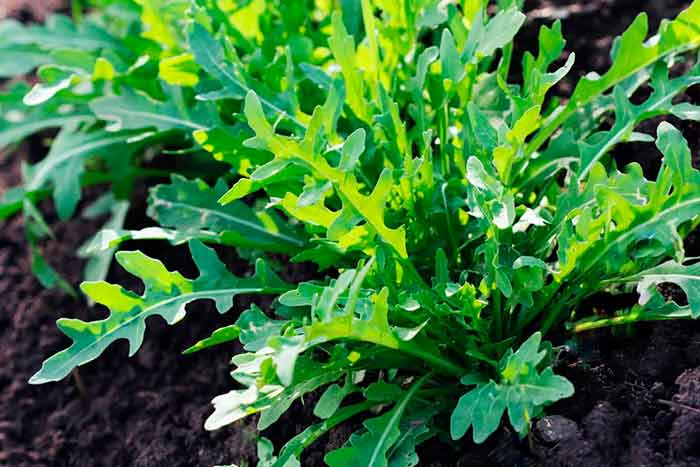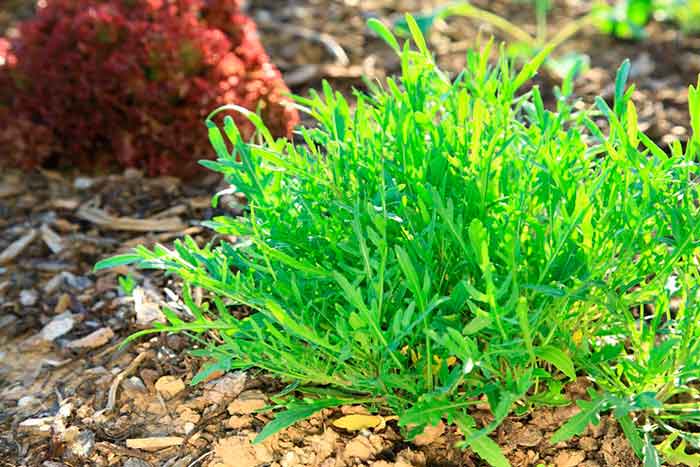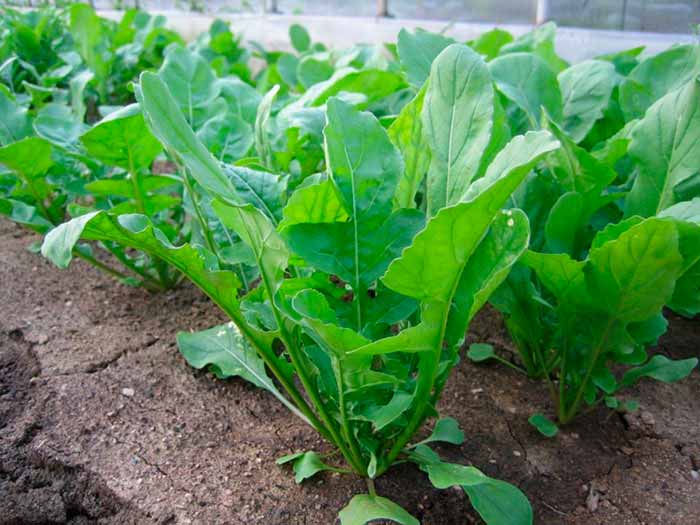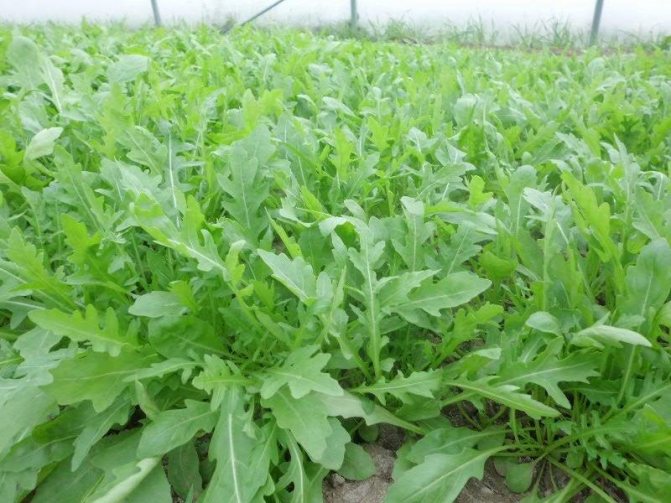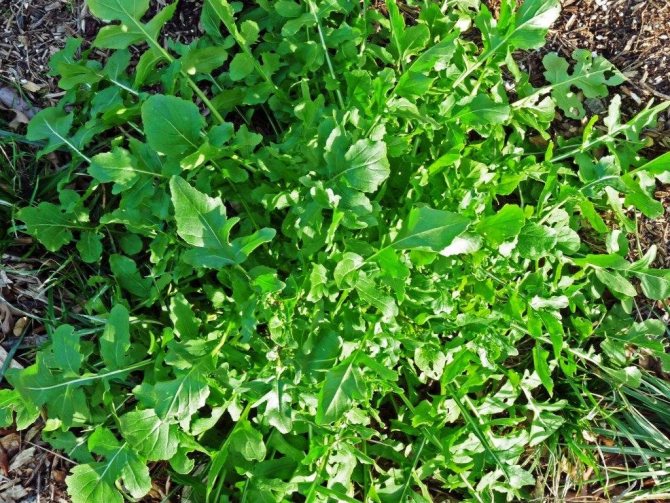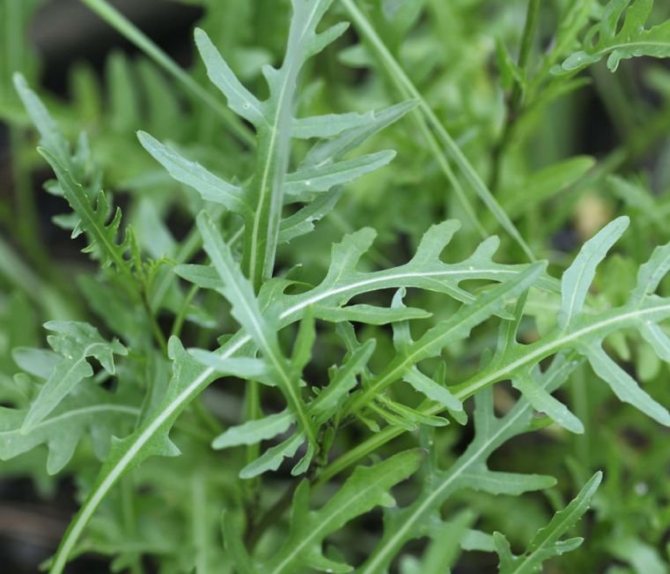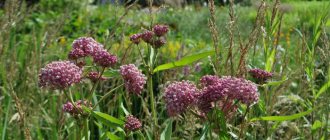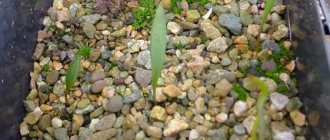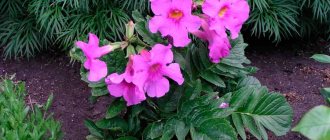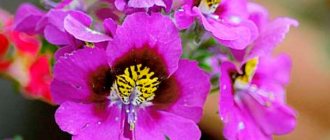Arugula is a herbaceous annual plant with long, dandelion-like leaves. It is a member of the Indau genus from the Cabbage family (Cruciferous). In its natural environment, it is found in Asia, the northern zone of Africa, and Central Europe. The first mention of the plant dates back to the 1st century. BC e. The inhabitants of Ancient Egypt and the Hellenes decorated snacks from beans and seafood with green carved leaves of arugula. The ancient Romans added the herb to salads and meat dishes. Ancient scientists discovered that Mediterranean greens have medicinal properties, are a natural energetic and a powerful aphrodisiac.
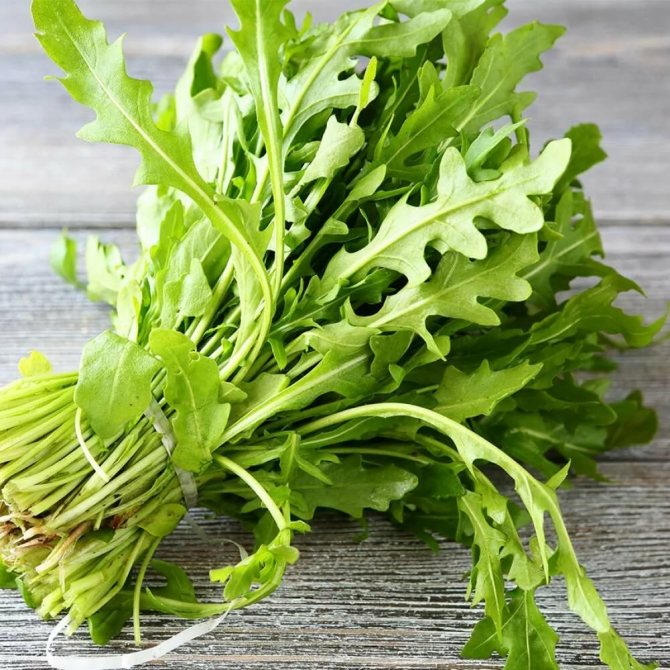
The mass cultivation of arugula is traditionally practiced in Italy. In Russia, birds and domestic animals were fed with this grass, it was considered a weed. Only from the end of the XX century. Russian chefs and housewives began to use it. Summer residents grow greens in the beds, calling it differently:
• indau;
• arugula;
• rocket salad;
• eruka;
• sowing caterpillar.
Spicy grass can be planted in the garden or at home, then there will always be fresh green leaves at hand for preparing and decorating salads and snacks.
Brief description of the plant
Arugula is a compact plant 30-60 cm high with a slightly pubescent branched stem. Depending on the variety, the leaves can be large and fleshy, or medium, thin and tender. In wild plants, they are narrower and more oblong. The lower lyre leaves form a rosette.
Arugula is grown both in the southern regions and the middle lane, and in places with a rather harsh climate.
Indau blooms in May-July with yellow or white flowers with purple veins. The shape of the flower is obovate, slightly notched. The plant is considered a good honey plant. The fruit is a xiphoid pod, inside which light brown seeds are located in 2 rows.
Popular varieties of arugula
In areas with warm climates, arugula is grown as a two-year crop. The root of the plant winters well in the soil. In the spring, the buds wake up on it, juicy greens grow. In the middle lane, varieties of annual arugula are popular:
• Arrows of Cupid - mid-season variety, ripens in 35 days; height of narrow leaves - up to 30 cm; blooms with pale yellow small flowers;
• Victoria - early ripening variety, ripens in 20 days; low bushes are abundantly covered with greenery;
• Poker - early maturing variety, ripening period - up to 22 days; bush height - 20 cm; leaves are large with a characteristic mustard flavor; cream-colored flowers;
• Spartak is an early ripening variety; bush height - 22 cm;
• Rocket - early ripening variety, ripening period - 20 days; dark green leaves are pinnately dissected, have a spicy mustard-nut flavor.
In garden stores, varieties of Euphoria, Dikovina, Olivette, Taganskaya Semko, Sicily are often found.
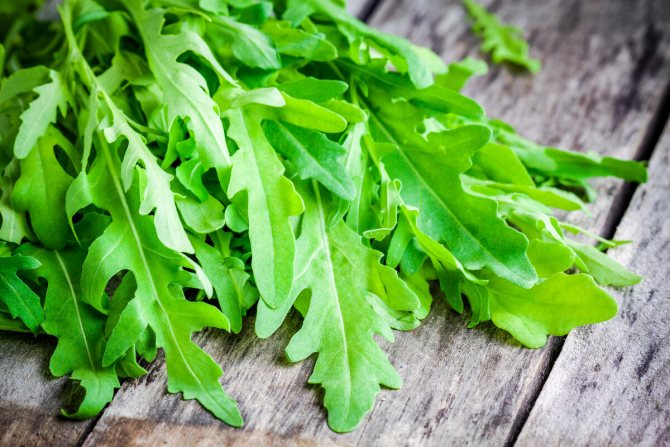

Timing of sowing arugula seeds in open ground
In open ground, Indau seeds are sown in April and August. The plant loves warmth, therefore, when planting in spring, you should wait until the air temperature reaches 8-10 degrees. Under favorable weather conditions, the sprouts hatch as early as 3-5 days after sowing the seeds.
Returning cold will not damage young seedlings, since the Indau without shelter tolerates short-term frosts down to -6 degrees.
In August, arugula should be sown when the summer heat subsides. For the western regions, this is the first decade of the month, for the more southern regions - the second and third. Experienced gardeners note that greens planted in spring have more juicy crisp leaves. When planted in autumn, the green mass is more voluminous, but not as juicy.
Arugula growing options
This plant can be grown in various conditions. Moreover, each cultivation option has its own cultivation technology, which must be adhered to.
In the greenhouse
In the greenhouse, you can maintain the optimal temperature regime (at least + 16 degrees) and effectively disinfect the soil. It is very important in the growing process - artificial lighting, timely feeding and watering. Growing arugula in a greenhouse allows you to get an earlier harvest of greens.
In the beds
This method is the least costly, but its use gives a significantly lower yield than when growing Arugula in a greenhouse. When growing outdoors, it is very important to know when to sow seeds. Arugula can be sown from mid-May to late August. The interval between crops should be 9-10 days. Semi-shaded areas are best suited for growing this crop.
Arugula plants cannot withstand exposure to direct sunlight.
The rest of the cultivation technology is quite standard with the use of timely watering, loosening and top dressing. In some years, pests and fungal diseases will have to be dealt with.
On the windowsill
In the absence of a land plot, you can grow Arugula at home on a windowsill. Planting is recommended in a container measuring 20 x 20 x 20 cm.
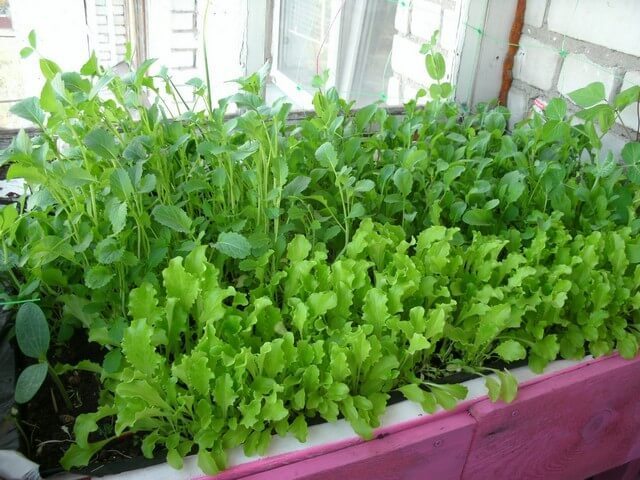

An important aspect is the optimal level of illumination and timely watering. In addition, it is necessary to use a fertile soil mixture with an optimal acidity parameter.
Rules for planting a plant in the garden
The plant does not tolerate too bright sun, so you should not choose open areas. An ideal option would be an area where it will be sunny until lunchtime, and in the hot midday hours there will be diffused shadow.
Arugula is not demanding on the soil, but it grows better in areas with light, well-fertilized soil with a neutral reaction. Acidic clay soils are not suitable for planting salad greens, so they must first be deoxidized with lime.
You should not choose areas with a high groundwater table, since waterlogging of the root system significantly increases the risk of fungal diseases.
Seed preparation
In order to get friendly Indau shoots in 5 days, the seeds should be prepared in a certain way before sowing. By purchasing seed in specialized stores from well-known manufacturers, you can be sure of their quality. Most often they have already been processed, so there is no need to decontaminate them.
Some gardeners prefer to buy seeds from their hands in the market or from neighbors. In this case, they should be disinfected without fail. Presowing seed dressing is carried out using a 3% hydrogen peroxide solution:
- heat the peroxide to 40 degrees;
- fill the seeds with the solution for 7-10 minutes;
- drain the solution;
- dry the seeds on a napkin.
If the quality of the seeds is suspicious, they can be germinated before sowing:
- soak the seed in Epin's solution for 2 hours;
- spread the seeds on a damp cloth and wrap;
- place the package in a container and close it with a lid;
- remove the homemade greenhouse in a warm place.
With this method of germination, the seeds hatch after a couple of days, after which they can be sown into the soil.
Soil preparation
The soil in the area where the rucola will be planted is prepared in the fall. First, dig up the area well and remove the weeds. Add 3 kg of compost, 15-20 g of potassium chloride and 20 g of superphosphate per sq. m. Dig up the area again and pour water over it.
In early spring, urea is introduced into the soil at the rate of 15 g per sq. m. In areas with high acidity of the soil, it is necessary to add 300-500 g of quicklime per sq. m. m for deoxidation. Immediately before planting, the soil is loosened and leveled.
Planting arugula in open ground
The scheme for planting arugula in open ground is not much different from the methods of sowing any other greenery:
- In the prepared area, make grooves no more than 1.5 cm deep and thoroughly pour water over them.
- Leave the distance between the rows about 30 cm.
- Sow the seeds at a distance of 5 cm from each other.
- Sprinkle soil over the beds and tamp it lightly.
- If there is a high probability of return frost, cover crops at night with plastic foil, remembering to remove it during the day.
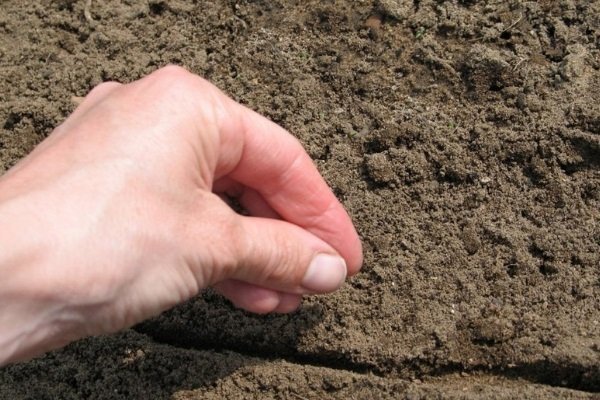

Good and bad predecessors
Arugula is best grown after vegetable crops such as potatoes, peas, pumpkin, carrots, or tomatoes. It is not recommended to occupy beds for planting greenery, where radish, turnip, cabbage, horseradish grew before. Arugula should be returned to its original place no earlier than after 4 years.
Pests and diseases of Arugula
Due to the presence of a large amount of essential oils in the leaves, Arugula plants are practically not damaged by pests, with the exception of cruciferous flea beetles. To combat these pests, it is advisable to spray with Karbofos, Lutrasil and Metaphos insecticides.
Of the diseases, the greatest harm to Arugula can be caused by fungal diseases. The first sign of such diseases is the formation of characteristic brown bubbles on the roots. If such bubbles are found, the plants should be treated with the fungicide Ridomil Gold.
Predecessors and neighbors of Arugula
To create a shading effect on the sun for Arugula, you need to plant corn or beans nearby.
The best precursors for Arugula are legumes, pumpkin, potatoes, tomatoes, and carrots.
Arugula care after planting
Arugula is an unpretentious plant, therefore, provided that it is properly planted, you will not need to spend too much time caring for it. All you need to do is provide the young greens with abundant watering, regularly remove weeds, and loosen the soil.
After the emergence of seedlings, it is necessary to thin out the planting. When 2 true leaves appear, remove excess shoots, leaving a distance of 5-7 cm. Carry out the next thinning at the stage of forming 4 true leaves. The distance between future bushes should remain about 15 cm.
Temperature
The optimum temperature for the development of Indau is 18-20 degrees. At lower thermometer readings, the plant slows down its growth and development, the growing season is significantly extended.
In the event of prolonged frosts, it is necessary to immediately build a shelter made of plastic wrap or any other covering material over the beds.
Too high air temperature also negatively affects the vegetation of the plant. Bushes can bloom prematurely, especially varieties that are not resistant to shooting.
In addition, an increased temperature during active growth of green mass leads to a decrease in its taste. Rucola leaves lose their juiciness, become rough and tasteless. This problem can be solved by stretching a special shading film over the area.
Watering
Arugula is a moisture-loving plant, therefore it requires frequent abundant watering. The soil in the root area should always be moist, but the water should not stagnate. The plant does not tolerate waterlogging. In regions with hot summers, watering is carried out daily, in cooler conditions - 3-4 times a week.
With a lack of moisture, the Indau leaves acquire bitterness and become unsuitable for human consumption.
Weeding and loosening
In order for oxygen and moisture to better penetrate the root zone, the soil around the bushes must be loosened regularly. It is easier to do this immediately after watering, using a hoe or horn. A mandatory measure is the removal of weeds, which thicken the plantings, and some also negatively affect the taste of salad greens.
Try to root out the weeds, otherwise they will soon reappear. If you are not a frequent visitor to your summer cottage, mulch the beds with hay or grass. This will not only inhibit the growth of weeds, but will also help retain moisture in the root zone for longer.
Top dressing
In matters of the need to make fertilizing for planting arugula, experts have different opinions. The fact is that the plant quite actively absorbs nitrates and other substances harmful to humans from the soil. Since the Indau has a short growing season, the accumulated toxins do not have time to fully decompose.
If you have prepared the site in advance before planting greenery, then the fertilizer applied is quite enough for a bountiful harvest. On poor soils with poor development of the bushes, you can use a solution of chicken manure in a ratio of 1:10 for feeding.
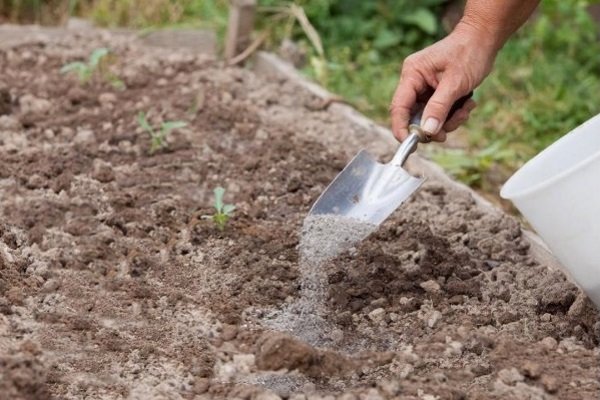

Some difficulties in growing arugula
Both plants are grown at home. Breeders have developed many varieties with a high growth rate.
Poker tastes good. Forms a rosette of 10 to 12 leaves, about 20 cm tall. The leaf mass is ready for cutting in 3 - 4 weeks.
Rococo
Spicy, aromatic greens can be eaten after 21 - 26 days.
Corsica
Cold-resistant grade. Has positive reviews from people who grew it indoors. Greens retain their tenderness and juiciness for a long time.
Spartacus
Succulent leaves are suitable for cutting at the age of 20 - 25 days. Perfect for windowsill cultivation.
Dikovina
Delicate spicy greens are ready to eat in 2 weeks. Leaves are cut before flowering.
Solitaire
Strongly dissected leaves form a rosette with a height of 18 cm. Suitable for potting.
Sometimes planting does not please with a friendly harvest, there are certain reasons for this.
- Seedlings are pale, thin, long - the reason is a lack of light. Additional lighting will help to correct the situation.
- The plant forms a small rosette, shoots quickly. This problem occurs at high ambient temperatures, insufficient watering.
- The taste is sharp, too bitter. The reason is low soil moisture. It is necessary to increase watering, avoiding stagnation of water.
- The leaves are stunted, turn yellow. The most common culprit is acidic, heavy soil with a dense texture.
What is the problem with rucola?
Arugula is susceptible to some fungal diseases, especially if the plant is not properly cared for. The main ones are:
- Fusarium. The diseased plant begins to chlorosis, then whitish spots appear on the leaves, the turgor decreases. Over time, the leaves begin to dry out, the stem darkens, and the aerial part dies off completely. Fusarium can not be cured, so the affected bushes are removed and burned.
- Peronosporosis. The appearance of a fungal disease is evidenced by the appearance of red-brown dry spots on the upper part of the leaves. Below you can see a weakly expressed mealy bloom. Leaves wrinkle and dry out. Fungicide treatments do not give the desired result, so the affected bushes should be removed.
- Verticillary wilting. The fungus enters the plant through small cracks, which are often formed after damage to the roots during loosening of the soil.In the initial stages, the disease does not manifest itself. During the period of active growth of the green mass, yellow and whitish spots appear on the leaves, which quickly spread throughout the plant. An affected rucola bush can wither completely in 1 day. If you notice signs of illness, immediately remove the plant from the garden and burn it.
The essential oils present in the leaves of the plant repel many pests. But sometimes rucola can fall prey to cruciferous fleas and cabbage moths. The first is capable of severely damaging young Indau greens, leaving small holes in it. To combat the pest, the plantings are covered with any garden non-woven material. As a preventive measure, you can sprinkle the bushes with wood ash.
The moth also loves to feast on fresh, spicy foliage. Arugula can be protected from it using folk methods by treating the plants with wormwood tincture. To prepare it, grind the wormwood and boil for 10 minutes in a little water. Cool and dilute with water in a 1: 1 ratio.
Description and useful properties of Arugula
Arugula is a close relative of cabbage and mustard. This is a plant with a lodging location of the aboveground part. With proper cultivation, its height reaches 40-65 cm. In our country, Arugula is cultivated as a leaf-type salad culture. It has many different names, of which the most popular are Indus, Rocket Salad, or Walker.
The leaves of the plant contain a large amount of vitamins B and C, as well as magnesium, zinc, iron. These substances have a positive effect on the immune system and reduce the number of dangerous bacteria throughout the body.
Arugula is an effective remedy for various stomach ailments. In addition, this plant has a positive effect on hair growth, strengthening nails and normalizing weight.
Harvesting greens
It is necessary to cut off young leaves of arugula as they grow, choosing the widest and longest ones. Harvest regularly, without overexposing the leaves on the bush, as they become stiffer over time. The optimum length of a leaf that has reached ripeness is 8-10 cm.
After the onset of flowering, the taste of salad greens is noticeably reduced. Some gardeners recommend removing the buds to lengthen the harvest period a bit. Arugula is consumed fresh, so it fully retains all its vitamins. Greens can be stored in the refrigerator for no more than 4 days.
How to grow arugula at home on a windowsill
Another name for arugula is Indau sowing, Caterpillar sowing or Eruka sowing. It is under these names that the seeds of this plant are sold.
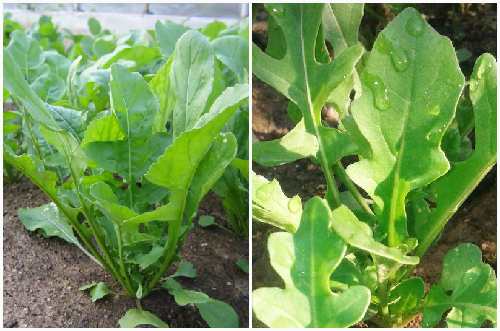

The culture grows up to 60 cm tall, wide leaf plates have a serrated edge.
Arugula is also called a completely different plant - a thin-leaved two-rowed plant. Unlike the Indau, the two-rowed is a perennial. Its narrow leaves have a heavily cut edge and taste sharper. The two-rowed plant is grown commercially and is sold under the name Wild Arugula.
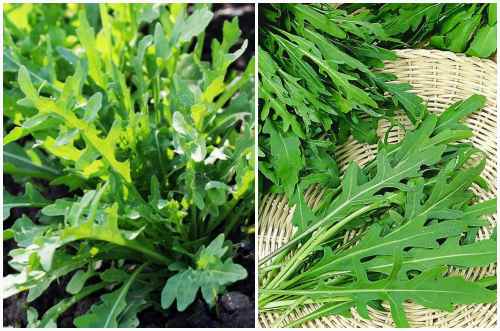

Collecting arugula seeds
Long daylight hours and insufficient watering contribute to the fact that arugula quickly sheds color. Leaving a few flowering plants in the garden at the end of July, you can harvest ripe green seeds by the beginning of autumn. It is recommended to store them in glass containers or special bags with a Zip-Lock fastener. The shelf life of Indau seeds without loss of germination is 3-4 years.
Arugula is an easy-to-grow plant that requires abundant watering and frequent loosening. If planted correctly, you will get a rich harvest of spicy greens without any additional feeding. By sowing seeds at several times, you will have a healthy vitamin salad on your table all summer.
0
Arugula on hydroponics
Many fast growing plants are successfully grown without soil, in nutrient solutions, this method is called hydroponics.
Experience has shown that it is quite problematic to grow arugula to marketable condition in this way. However, this option is acceptable for obtaining microgreens. The seeds are sown on hydrogel, wet sawdust, or even toilet paper. The most important thing is to prevent the substrate from drying out. Microgreens can be cut as early as 7 days after germination.
This video will show you how to grow arugula in an ordinary flower pot.


